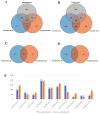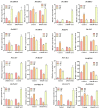Transcriptome Analysis of Populus euphratica under Salt Treatment and PeERF1 Gene Enhances Salt Tolerance in Transgenic Populus alba × Populus glandulosa
- PMID: 35409087
- PMCID: PMC8998595
- DOI: 10.3390/ijms23073727
Transcriptome Analysis of Populus euphratica under Salt Treatment and PeERF1 Gene Enhances Salt Tolerance in Transgenic Populus alba × Populus glandulosa
Abstract
Populus euphratica is mainly distributed in desert environments with dry and hot climate in summer and cold in winter. Compared with other poplars, P. euphratica is more resistant to salt stress. It is critical to investigate the transcriptome and molecular basis of salt tolerance in order to uncover stress-related genes. In this study, salt-tolerant treatment of P. euphratica resulted in an increase in osmo-regulatory substances and recovery of antioxidant enzymes. To improve the mining efficiency of candidate genes, the analysis combining both the transcriptome WGCNA and the former GWAS results was selected, and a range of key regulatory factors with salt resistance were found. The PeERF1 gene was highly connected in the turquoise modules with significant differences in salt stress traits, and the expression levels were significantly different in each treatment. For further functional verification of PeERF1, we obtained stable overexpression and dominant suppression transgenic lines by transforming into Populus alba × Populusglandulosa. The growth and physiological characteristics of the PeERF1 overexpressed plants were better than that of the wild type under salt stress. Transcriptome analysis of leaves of transgenic lines and WT revealed that highly enriched GO terms in DEGs were associated with stress responses, including abiotic stimuli responses, chemical responses, and oxidative stress responses. The result is helpful for in-depth analysis of the salt tolerance mechanism of poplar. This work provides important genes for poplar breeding with salt tolerance.
Keywords: PeERF1; Populus euphratica; WGCNA; salt stress; transcriptome.
Conflict of interest statement
The authors declare no conflict of interest.
Figures












Similar articles
-
PeCLH2 Gene Positively Regulate Salt Tolerance in Transgenic Populus alba × Populus glandulosa.Genes (Basel). 2023 Feb 21;14(3):538. doi: 10.3390/genes14030538. Genes (Basel). 2023. PMID: 36980811 Free PMC article.
-
Combined transcriptomic and metabolomic analysis revealed the salt tolerance mechanism of Populus talassica × Populus euphratica.BMC Plant Biol. 2025 Mar 20;25(1):361. doi: 10.1186/s12870-025-06288-1. BMC Plant Biol. 2025. PMID: 40114044 Free PMC article.
-
Transcriptomic Profile Analysis of Populus talassica × Populus euphratica Response and Tolerance under Salt Stress Conditions.Genes (Basel). 2022 Jun 8;13(6):1032. doi: 10.3390/genes13061032. Genes (Basel). 2022. PMID: 35741794 Free PMC article.
-
Salinity tolerance of Populus.Plant Biol (Stuttg). 2010 Mar;12(2):317-33. doi: 10.1111/j.1438-8677.2009.00301.x. Plant Biol (Stuttg). 2010. PMID: 20398238 Review.
-
Genome-wide Identification of WRKY Genes in the Desert Poplar Populus euphratica and Adaptive Evolution of the Genes in Response to Salt Stress.Evol Bioinform Online. 2015 Aug 5;11(Suppl 1):47-55. doi: 10.4137/EBO.S22067. eCollection 2015. Evol Bioinform Online. 2015. PMID: 26309388 Free PMC article. Review.
Cited by
-
Dynamic Metabolic Responses of Resistant and Susceptible Poplar Clones Induced by Hyphantria cunea Feeding.Biology (Basel). 2024 Sep 14;13(9):723. doi: 10.3390/biology13090723. Biology (Basel). 2024. PMID: 39336150 Free PMC article.
-
Integrated metabolomic and transcriptomic analysis reveals the role of phenylpropanoid biosynthesis pathway in tomato roots during salt stress.Front Plant Sci. 2022 Dec 8;13:1023696. doi: 10.3389/fpls.2022.1023696. eCollection 2022. Front Plant Sci. 2022. PMID: 36570882 Free PMC article.
-
Acclimation of sugar beet in morphological, physiological and BvAMT1.2 expression under low and high nitrogen supply.PLoS One. 2022 Nov 29;17(11):e0278327. doi: 10.1371/journal.pone.0278327. eCollection 2022. PLoS One. 2022. PMID: 36445927 Free PMC article.
-
Populus euphratica GRP2 Interacts with Target mRNAs to Negatively Regulate Salt Tolerance by Interfering with Photosynthesis, Na+, and ROS Homeostasis.Int J Mol Sci. 2024 Feb 7;25(4):2046. doi: 10.3390/ijms25042046. Int J Mol Sci. 2024. PMID: 38396725 Free PMC article.
-
PeCLH2 Gene Positively Regulate Salt Tolerance in Transgenic Populus alba × Populus glandulosa.Genes (Basel). 2023 Feb 21;14(3):538. doi: 10.3390/genes14030538. Genes (Basel). 2023. PMID: 36980811 Free PMC article.
References
-
- Kazuo S., Kazuko Y.S. Gene networks involved in drought stress response and tolerance. J. Exp. Bot. 2007;58:221–227. - PubMed
-
- Zeng F., Shabala S., Maksimović J.D., Maksimović V., Bonales-Alatorre E., Shabala L., Yu M., Zhang G., Živanović B.D. Revealing mechanisms of salinity tissue tolerance in succulent halophytes: A case study for Carpobrotus rossi. Plant Cell Environ. 2018;41:2654–2667. doi: 10.1111/pce.13391. - DOI - PubMed
MeSH terms
LinkOut - more resources
Full Text Sources
Miscellaneous

